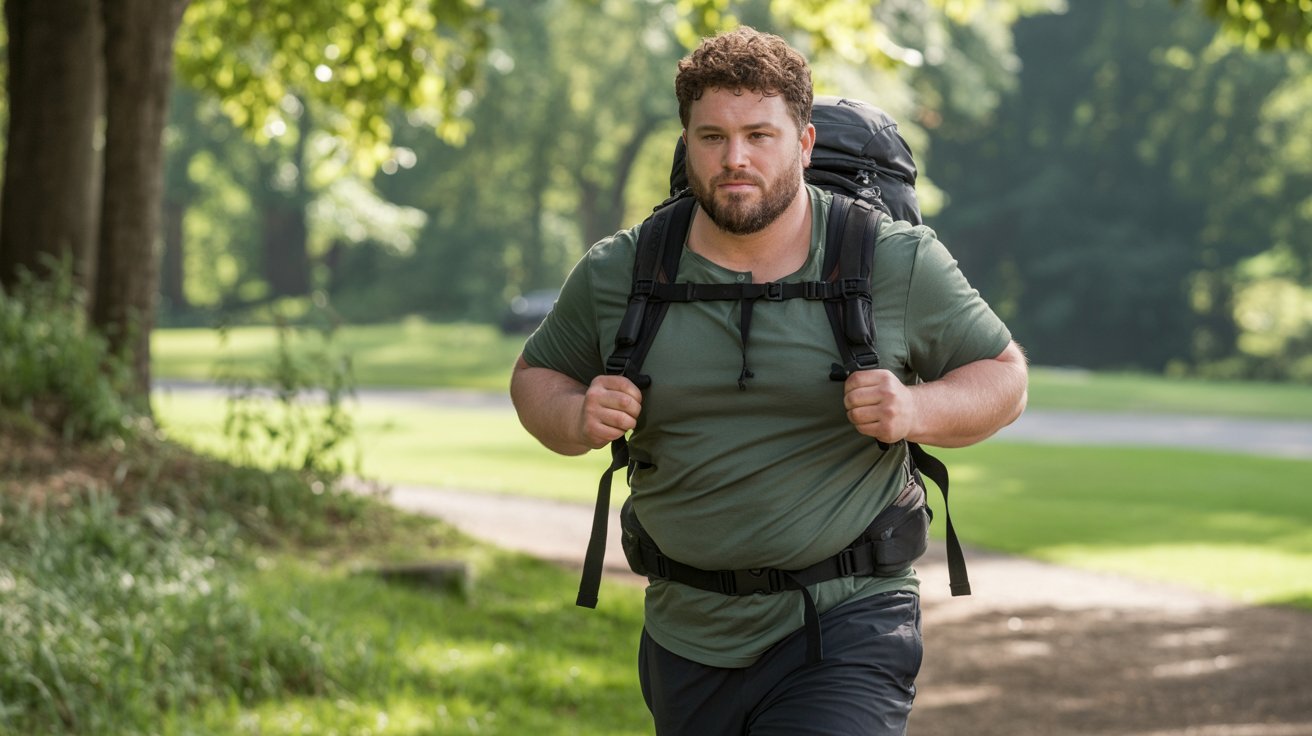Rucking is gaining popularity for weight loss. It combines walking with a weighted backpack.
This simple exercise boosts calorie burn and builds strength. It’s an accessible, effective way to shed pounds while exploring the outdoors. Rucking offers a unique twist on traditional cardio workouts. It requires minimal equipment and suits all fitness levels. The added weight increases resistance, making your walk more challenging.
This helps burn more calories than regular walking. Plus, it strengthens your core and lower body muscles. The benefits extend beyond weight loss, improving endurance and overall fitness. Rucking also allows you to enjoy fresh air and scenic routes. It’s a versatile activity, whether in a park or urban setting. As an added bonus, it can be social, allowing friends or groups to join in. Ready to lace up your boots and grab your pack? Let’s dive into the world of rucking for weight loss.
Introduction To Rucking
Have you ever heard of rucking? If not, you’re in for a treat. This simple yet effective exercise is taking the fitness world by storm. It’s a fantastic way to lose weight while enjoying the great outdoors. Whether you’re a seasoned athlete or a beginner, rucking offers something for everyone. Let’s dive into what makes rucking such a unique and accessible workout.
What Is Rucking?
Rucking is walking with a weighted backpack. Sounds simple, right? But don’t let its simplicity fool you. This activity can transform your fitness routine. Rucking originates from military training, where soldiers carry heavy gear over long distances. Today, it’s a popular exercise for weight loss and building endurance. All you need is a sturdy backpack, some weights, and a good pair of walking shoes.
Benefits Of Rucking
Rucking is a full-body workout that burns calories efficiently. It’s more intense than regular walking, yet it’s easier on your joints than running. This makes it perfect for those looking to shed pounds without risking injury. Plus, it strengthens your legs, core, and back. Imagine feeling stronger with each step you take. It’s a great way to boost cardiovascular health, too.
Rucking also enhances mental resilience. Carrying weight while walking challenges you both physically and mentally. It pushes you to keep going even when it gets tough. Have you ever felt that sense of achievement after completing a challenging task? That’s the feeling rucking can give you. It’s not just about losing weight; it’s about gaining confidence and determination.
Ready to give rucking a try? Grab a backpack, add some weight, and hit the trails. You might be surprised at how quickly this simple exercise can become a favorite part of your fitness journey. What weights will you start with, and where will your rucking adventures take you?

Credit: www.goruck.com
Rucking And Weight Loss
Rucking blends walking with carrying weight, making it a unique exercise. This low-impact workout helps with weight loss. It boosts calorie burn and metabolism. A ruck involves a backpack filled with weights. It’s simple yet effective. Many find it enjoyable and sustainable. Rucking can fit into busy schedules. It’s more than a workout; it’s a lifestyle change.
Calorie Burn Explained
Rucking burns more calories than walking. The added weight increases effort. More effort means more calories burned. The heavier the ruck, the more you burn. Calorie burn varies with weight and speed. A 150-pound person burns about 400 calories per hour. This makes rucking a great choice for weight loss. It’s simple and effective.
Metabolism Boost
Rucking boosts metabolism. It engages more muscles than walking alone. This leads to increased energy expenditure. A higher metabolism helps burn fat faster. Rucking strengthens muscles and bones. It improves endurance and cardiovascular health. These benefits enhance your metabolic rate. A stronger metabolism aids long-term weight management. Rucking supports a healthy, active lifestyle.
Essential Gear For Rucking
Rucking aids weight loss with a backpack and sturdy shoes. Comfortable gear enhances your workout. Hydration packs and reflective gear ensure safety and endurance.
Embarking on a rucking journey for weight loss is not just about walking with a backpack. It’s about equipping yourself with the right gear to ensure a safe and effective workout. Rucking can be a powerful way to shed pounds, but the gear you choose plays a crucial role in your success. Let’s delve into the essentials that will help you make the most of your rucking experience. ###Choosing The Right Backpack
The backpack is your closest companion on a rucking mission. You need one that’s comfortable, durable, and fits well. Look for a backpack with padded shoulder straps and a supportive waist belt. This will help distribute the weight evenly across your body, reducing strain on your shoulders and back. Consider the size of the backpack. It should be large enough to hold your weights securely but not so big that it becomes cumbersome. A backpack with multiple compartments can help organize your items and prevent shifting during movement. When I first started rucking, I chose a backpack that was too large and poorly padded. It led to discomfort and cut my sessions short. Learn from my mistake—invest in a quality backpack that’s designed for physical activity. What features do you prioritize in a backpack? ###Weight Selection Tips
Choosing the right weight is critical to the effectiveness of your rucking workout. Begin with a lighter load to allow your body to adjust. A good starting point might be around 10% of your body weight. As you build strength and endurance, gradually increase the weight. Aim for a balance where you’re challenged but not overexerted. It’s important to listen to your body and avoid jumping into heavy weights too quickly. Using household items like water bottles or bags of rice can be an economical way to add weight. Secure these items to prevent them from moving around as you ruck. What creative ways have you found to add weight to your ruck? Remember, the goal is to improve your fitness and lose weight without injury. With the right gear and a thoughtful approach, rucking can become a staple in your fitness routine. What adjustments will you make to your rucking gear to enhance your workouts?
Credit: www.goruck.com
Getting Started With Rucking
Rucking offers an effective way to lose weight by combining walking with a weighted backpack. This activity boosts calorie burn, strengthens muscles, and improves endurance. Ideal for those seeking a simple, low-impact workout.
Are you looking to shed some pounds while enjoying the fresh air? Rucking might be the perfect workout for you. It’s simple, effective, and doesn’t require fancy gym equipment. Plus, it’s a great way to combine cardio and strength training. But how do you get started with rucking? Let’s break it down into easy, actionable steps.Beginner’s Guide
Begin with choosing the right backpack. It should be comfortable and have padded shoulder straps. Add weight gradually, starting with 10% of your body weight. You can use books or water bottles as weights. Pick a location that inspires you. A scenic park or a quiet neighborhood can make your rucking sessions enjoyable. Start with short distances to get your body accustomed to the weight. Adjust your pace to maintain a steady heart rate. A brisk walk is sufficient to burn calories. As your stamina improves, increase your speed or distance gradually.Safety Precautions
Ensure your backpack fits properly. An ill-fitting backpack can lead to back or shoulder pain. Adjust the straps so that the weight is evenly distributed. Stay hydrated during your rucking sessions. Carry a water bottle, especially on hot days. Dehydration can lead to fatigue and muscle cramps. Choose appropriate footwear with good arch support. Walking long distances with extra weight can be hard on your feet. Invest in sturdy shoes to prevent discomfort or injury. Are you ready to embrace rucking as your new fitness routine? Imagine the pounds melting away while you enjoy the great outdoors. What could be more motivating than that?Incorporating Rucking Into Fitness Routine
Rucking combines walking with carrying weight, making it an effective way to burn calories and lose weight. This low-impact exercise boosts cardio fitness and strengthens muscles, helping achieve weight loss goals. Integrating rucking into your routine offers a simple and enjoyable method for shedding pounds.
Incorporating rucking into your fitness routine can be a game-changer if you’re looking to boost weight loss and improve endurance. Rucking, which involves walking with a weighted backpack, is a simple yet effective way to burn calories and build strength. It’s a versatile workout that can easily fit into your existing schedule without needing a complete overhaul of your routine. ###Weekly Schedule Ideas
Creating a weekly rucking schedule can help you stay consistent and track progress. Start with two to three rucking sessions per week, gradually increasing the distance and weight as your stamina improves. Consider a schedule like this: – Monday: Short ruck, 1-2 miles with light weight – Wednesday: Medium ruck, 3-4 miles with moderate weight – Saturday: Long ruck, 5-6 miles with heavier weight Think about how you can fit these sessions into your week. Could a lunchtime ruck at work be a refreshing break? Or perhaps an early morning session to start your day on a high note? ###Combining With Other Exercises
Rucking can be effectively combined with other exercises to enhance your fitness routine. Pair it with strength training to build muscle and increase metabolism. You might ruck on alternate days, allowing your muscles to recover while keeping your body active. Mixing rucking with cardio workouts like cycling or jogging can also boost cardiovascular health. A combination of these activities can break the monotony and keep your routine exciting. Have you considered how rucking could complement your favorite workout? Imagine the satisfaction of completing a ruck after a yoga session, feeling both grounded and accomplished. By thoughtfully adding rucking into your fitness plan, you can make your workouts more dynamic and enjoyable. Start small, listen to your body, and watch how this simple activity transforms your fitness journey.Tracking Progress And Setting Goals
Tracking progress is crucial in a weight loss journey. It helps you stay motivated and focused. Setting goals is equally important. It gives direction and purpose to your efforts. Rucking can be an effective way to lose weight. But, without a plan, it’s easy to lose track. This section guides you on how to monitor your progress. It also helps you set realistic targets for success.
Monitoring Weight Loss
Use a journal to track your weight regularly. Write down your weight each week. Notice any patterns or changes. This helps you understand your body’s response. Many people find it helpful to take measurements too. Measure your waist, hips, and other key areas. This gives a fuller picture of your progress. Tracking your distance and time rucking can be motivating. Apps or fitness trackers can help. They provide data on calories burned and miles covered. Simple tools for better progress monitoring.
Setting Realistic Targets
Start by setting small, achievable goals. Aim to lose 1-2 pounds per week. This is a healthy and sustainable rate. Extreme goals can lead to disappointment. Instead, focus on gradual progress. Consider setting targets for rucking sessions. Increase your distance or time as you improve. Celebrate small victories along the way. These achievements keep you motivated. Remember, every step counts toward your goal.
Common Mistakes And How To Avoid Them
Rucking offers an effective way to lose weight and get fit. But, making mistakes can hinder your progress. Avoid common pitfalls to maximize your results. This section guides you through common rucking mistakes. Learn how to avoid them for better results.
Overloading Backpack
Many people overload their backpacks with too much weight. This can lead to injury and fatigue. Start with a lighter load and gradually increase it. Use weights that challenge you but do not strain your body. Aim for about 10% of your body weight. This ensures effective workouts without risking injury.
Ignoring Rest Days
Rest days are crucial for muscle recovery and growth. Skipping them can lead to overtraining and burnout. Plan rest days in your rucking routine. Listen to your body’s signals and adjust as needed. Rest helps maintain energy and prevents fatigue. It also reduces the risk of injury, keeping you on track with your goals.
Success Stories And Inspiration
Discover inspiring success stories of individuals shedding pounds through rucking. This weight-loss method combines walking with a backpack, offering a simple yet effective exercise. Transformative journeys highlight the benefits of adding weight to a walk, making fitness goals achievable for all.
Rucking has gained popularity as an effective method for weight loss. The stories of individuals who have transformed their lives through this simple yet powerful activity offer motivation and hope. Hearing about real successes can be the push you need to lace up your boots and get moving.Real-life Transformations
Consider Sarah, a mother of two, who struggled with weight for years. She started rucking with a 10-pound backpack, gradually increasing the weight as her stamina grew. In six months, she lost 30 pounds and discovered a newfound love for outdoor adventures. John, a former athlete, found himself gaining weight after leaving competitive sports. Rucking reintroduced him to a sense of discipline. He combined it with a balanced diet and dropped 40 pounds in a year, regaining his confidence and energy. These stories are not unique. They reflect the potential of rucking to bring about real, lasting change. What could your transformation story be if you gave rucking a try?Community Support
Joining a community can amplify your rucking journey. Many rucking enthusiasts gather in local groups to motivate each other. This support network can be invaluable, especially on days when you feel like giving up. Online communities also offer a space to share experiences and tips. Platforms like Reddit and Facebook host groups where ruckers share their challenges and triumphs. Being part of a community keeps you accountable and inspired. Do you have a local rucking group in your area? If not, consider starting one. The collective energy of a group can propel you toward your weight loss goals faster than you might think. By hearing these success stories and engaging with a community, you gain not only inspiration but also practical insights. What are the first steps you can take today to start your own rucking success story?
Credit: www.reddit.com
Frequently Asked Questions
Can I Lose Weight From Rucking?
Yes, rucking helps with weight loss. It combines walking and carrying weight, boosting calorie burn and building muscle. Regular rucking enhances endurance, promoting fat loss. It’s an effective and enjoyable exercise for shedding pounds. Remember to start with manageable weights and gradually increase intensity for best results.
What Are The Cons Of Rucking?
Rucking can cause joint strain, especially on knees and ankles. Carrying heavy loads may lead to back pain. Overexertion increases the risk of injury. Blisters and foot discomfort are common. Not suitable for those with existing health issues. Proper technique and gradual progression are crucial to avoid negative effects.
How Long Does It Take To See Results From Rucking?
Results from rucking vary by individual fitness level and consistency. Generally, noticeable improvements appear in 4 to 6 weeks. Regular rucking boosts endurance, muscle strength, and weight loss. Gradual progress ensures safety and effectiveness. Monitor your performance weekly to stay motivated and track your achievements.
How Many Miles Should I Ruck A Day?
Ruck 3-5 miles daily for fitness. Beginners should start with 1-2 miles, gradually increasing distance. Adjust based on fitness level and goals. Listen to your body to avoid overexertion.
Conclusion
Rucking offers a simple path to weight loss. Strap on a backpack. Start walking. The added weight increases your calorie burn. It’s easy and effective. You don’t need special skills or equipment. Just comfortable shoes and a sturdy backpack. Enjoy the outdoors while getting fit.
Rucking can be part of your daily routine. It’s social too. Walk with friends or join a group. See progress over time. Feel stronger. Lose weight. Improve health. Rucking is a great way to stay active. Try it and see the difference.
Keep moving, keep losing. Your fitness journey begins with that first step.








